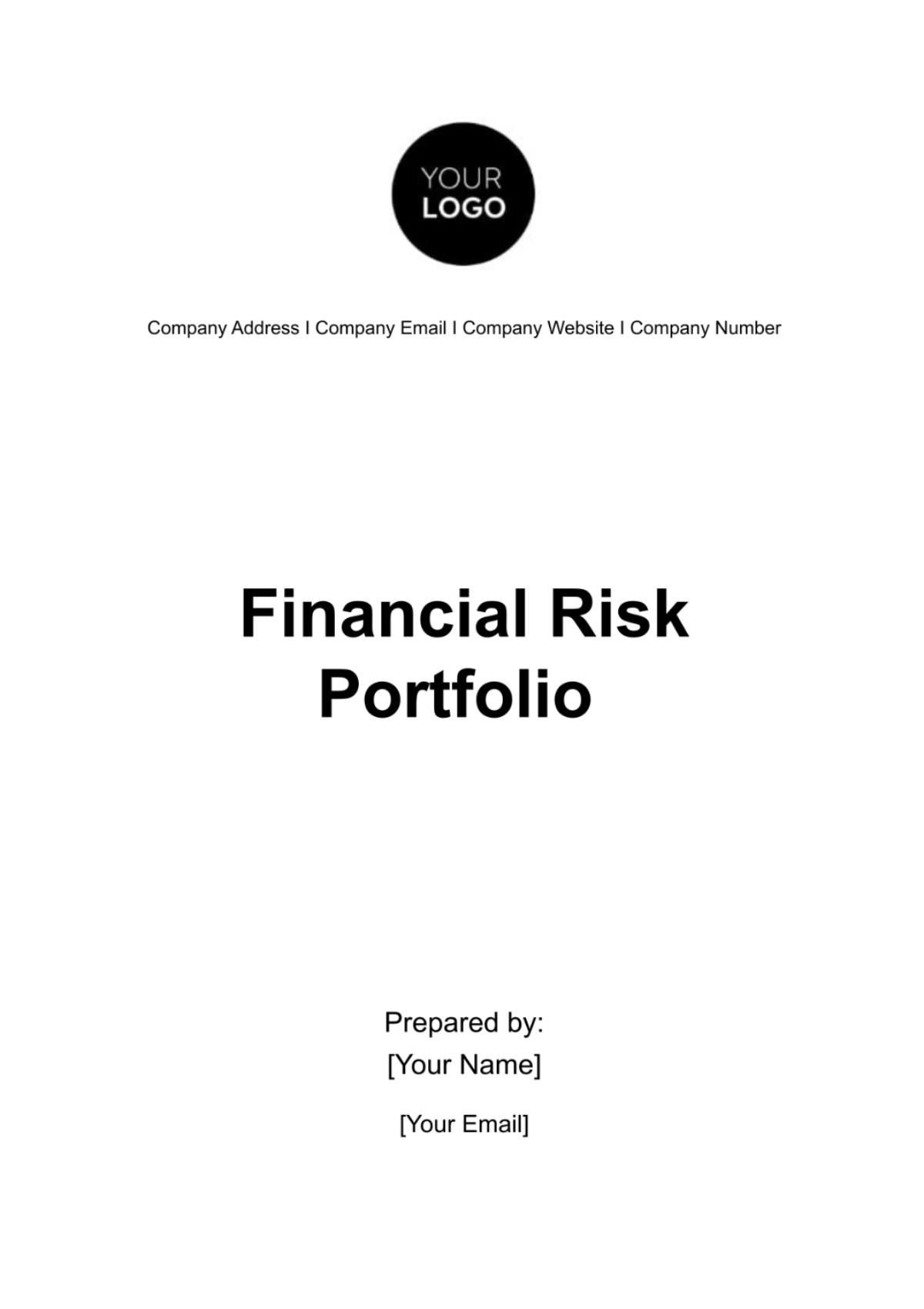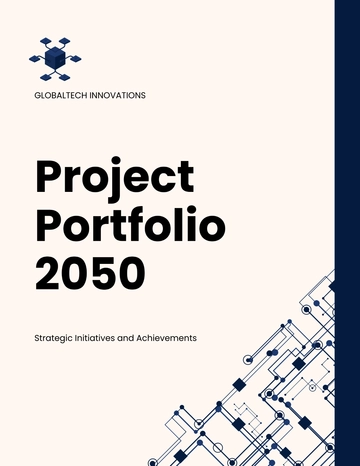Free Financial Risk Portfolio

I. Executive Summary
This document provides a high-level synopsis of our comprehensive approach to identifying, assessing, managing, and mitigating the financial risks inherent in our operations and investment activities. As a dynamic and forward-looking entity, our priority is to ensure a robust and resilient financial strategy that aligns with our overall business objectives and maintains our competitive edge in the market.
Our Financial Risk Portfolio has been developed to provide an integrated view of the various financial risks we face, including market, credit, liquidity, operational, compliance/legal, and strategic risks. Through rigorous analysis and industry-standard methodologies such as Value at Risk (VaR), Stress Testing, and Sensitivity Analysis, we have quantified our risk exposures and developed tailored mitigation strategies to safeguard our assets and ensure long-term stability.
II. Introduction
The Financial Risk Portfolio is a dynamic document designed to identify, quantify, analyze, and manage the financial risks faced by [Your Company Name]. Its primary purpose is to ensure that our financial risk management strategies are aligned with our overall business objectives and risk appetite. This document covers a range of risks including market, credit, liquidity, operational, compliance/legal, and strategic risks. It provides the framework for ongoing risk assessment, mitigation, monitoring, and reporting.
III. Risk Identification
At [Your Company Name], we've identified a broad range of financial risks that could impact our business operations and financial health. Here's a detailed look at each risk category:
Market Risk
Interest Rate Risk: Exposure to losses due to fluctuations in interest rates.
Equity Price Risk: Risk of loss from movements in equity prices.
Foreign Exchange Risk: Potential losses from adverse currency rate movements.
Commodity Price Risk: Exposure to volatile commodity prices.
Credit Risk
Counterparty Risk: Risk of loss from a counterparty failing to meet contractual obligations.
Country Risk: Risk arising from investing or trading in a particular country.
Concentration Risk: High exposure to a single counterparty or group.
Liquidity Risk
Funding Liquidity Risk: Inability to obtain funds to meet cash flow needs.
Market Liquidity Risk: Difficulty in selling assets without significant price changes.
Operational Risk
Process Failure: Losses from failed internal processes.
Systems Failure: Disruptions due to technology breakdowns.
External Events: Risks from natural disasters, terrorism, or other external events.
Compliance/Legal Risk
Regulatory Risk: Exposure to fines and penalties due to non-compliance with laws.
Legal Risk: Risks from lawsuits or legal disputes.
Strategic Risk
Business Model Risk: Risks related to the viability of business strategy.
Reputation Risk: Damage to reputation affecting business prospects.
IV. Risk Quantification and Analysis
We employ several quantitative and qualitative methods to measure and understand our risk exposure. Below are the methodologies and analyses for each risk type:
Value at Risk (VaR)
A statistical technique to estimate the maximum potential loss over a specified time period within a given confidence interval. We apply VaR to measure market and credit risk.
Stress Testing
We simulate extreme market conditions to understand the potential impact on our portfolio. This is crucial for liquidity and market risk management.
Sensitivity Analysis
By adjusting various inputs and assumptions, we can determine how changes in market conditions might affect our financial positions. This is applied across all risk types.
V. Risk Correlation and Concentration
Understanding the relationship between different risks and identifying areas of concentration is crucial for effective risk management.
Correlation Analysis
Risk Types | Correlation Coefficient |
|---|---|
Market & Credit | 0.6 |
Credit & Liquidity | 0.45 |
Market & Operational | 0.3 |
Risk Concentration
Geographic Concentration: Higher exposure in certain regions, requiring regional diversification.
Asset Concentration: Large positions in certain asset classes, needing broader asset allocation.
Scenario Analysis: We conduct scenario analyses for correlated events like simultaneous market downturns and credit default spikes. This helps us understand the aggregate effect of multiple risk occurrences.
VI. Risk Appetite and Tolerance
[Your Company Name] has a clearly defined risk appetite and tolerance levels that guide our investment and operational decisions.
Risk Appetite Statement: "At [Your Company Name], we are committed to pursuing sustainable growth while maintaining a moderate risk profile, ensuring financial stability, and protecting stakeholder value."
Risk Tolerance Levels
Risk Types | Tolerance Level |
|---|---|
Market Risk | Moderate |
Credit Risk | Low |
Liquidity Risk | Low |
Operational Risk | Moderate |
Our risk tolerance levels are aligned with our strategic goals of expanding market share, launching innovative products, and delivering consistent shareholder returns.
VII. Risk Mitigation Strategies
To manage and mitigate the identified risks effectively, we have developed comprehensive strategies:
Hedging: Using forward contracts and options to mitigate foreign exchange and commodity price risks.
Insurance: Protecting against operational risks through comprehensive insurance policies covering property, cyber risks, and key personnel.
Diversification: Spreading investments across various asset classes, industries, and geographies to reduce concentration risk.
Avoidance: Choosing not to engage in high-risk markets or products that exceed our risk appetite.
Acceptance: Allocating capital reserves for certain accepted risks and establishing contingency plans.
VIII. Portfolio Risk Management
Our portfolio risk management approach involves careful asset allocation and performance measurement:
Asset Allocation
Asset Types | Allocation % |
|---|---|
Equities | 40% |
Bonds | 30% |
Commodities | 10% |
Cash and Equivalents | 20% |
Risk-Adjusted Return Measures: We regularly calculate the Sharpe Ratio and Risk-Adjusted Return on Capital (RAROC) to ensure we are adequately compensated for the risks taken.
Limits and Thresholds: We have set limits on investment positions, sector exposures, and risk capital allocation to ensure compliance with our risk appetite.
IX. Monitoring and Reporting
At [Your Company Name], we believe that continuous monitoring and transparent reporting are fundamental to effective financial risk management. Our approach is designed to ensure timely identification and response to risk exposure changes, keeping all stakeholders informed and involved in risk mitigation.
Monitoring Systems and Processes
Our monitoring systems are an integral part of our risk management framework, equipped with real-time data feeds and analytical tools to track market conditions, portfolio performance, and other risk factors. Here's how we monitor our risks:
Market and Credit Risk: We use automated systems to monitor market movements and credit exposures continuously. These systems alert our risk management team to significant market events or credit quality deteriorations, allowing for quick response.
Liquidity Risk: Cash flow projections and liquidity ratios are monitored daily. We maintain a liquidity buffer to manage unexpected cash flow needs and regularly test our liquidity contingency plans.
Operational Risk: We track operational risk indicators such as transaction errors, system downtimes, or breaches in controls. Regular audits and employee training help in the early detection and prevention of operational risks.
Compliance/Legal Risk: Compliance teams stay updated with regulatory changes and ensure that all new regulations are incorporated into our monitoring systems. Regular compliance checks and audits are performed to prevent legal and regulatory breaches.
Strategic Risk: Strategic risks are monitored through regular market analysis, competitor analysis, and performance against strategic objectives. This helps in identifying shifts in the business environment that may affect our strategy.
Reporting Format and Frequency
Our reporting process is designed to provide clear, concise, and actionable information to management, the board, and other stakeholders. Reports are tailored to the needs of each audience, ensuring that they receive relevant information in an understandable format. Here's how our reporting works:
Regular Risk Reports: These are generated monthly, providing an update on risk exposures, limit breaches, and mitigation actions taken. They include executive summaries for quick review and detailed appendices for in-depth analysis.
Event-Driven Reports: In response to significant market events or identified risks, ad-hoc reports are generated to assess the impact and propose response strategies.
Board and Committee Reports: Quarterly reports are provided to the board and relevant committees, offering a high-level view of the overall risk posture and strategic implications.
We have established a set of KRIs for each risk category, providing early warning signs of increasing risk exposure. These indicators are continuously tracked, and predefined triggers prompt a review or escalation of risk management actions. Examples of KRIs include loan default rates, market volatility indices, operational loss metrics, or changes in credit ratings. Triggers might be set as thresholds, trends, or specific events that warrant closer attention or immediate action.
X. Review and Update Mechanism
Recognizing the dynamic nature of the financial market and the evolving landscape of risks, [Your Company Name] is committed to regularly reviewing and updating our Financial Risk Portfolio. This ensures our risk management strategies and practices remain effective and aligned with our changing business needs and external environment.
Schedule for Regular Review
Our Financial Risk Portfolio undergoes a comprehensive review on a semi-annual basis. However, components of the portfolio, especially those related to fast-changing risks like market and credit risks, are reviewed more frequently. The regular review includes:
Assessment of New Risks: Identifying and assessing any new risks that have emerged since the last review.
Effectiveness of Risk Mitigation Strategies: Evaluating the effectiveness of existing risk mitigation strategies and determining if adjustments are needed.
Alignment with Business Objectives: Ensuring that the risk management approach is still aligned with the overall strategic objectives and risk appetite of the company.
Process for Updating Risk Assessments and Strategies
Any updates to the risk assessments or management strategies follow a structured process, which includes:
Risk Assessment Updates: Based on new data, market developments, or business changes, risk assessments are updated to reflect the current environment.
Strategy Formulation: New or adjusted strategies are formulated to address any changes in the risk profile. This might involve adopting new risk mitigation tools, reallocating resources, or changing risk limits.
Approval and Implementation: Updates are reviewed and approved by the risk management committee and, where appropriate, the board of directors. Once approved, the changes are implemented across the organization.
Revision History and Document Control
To maintain the integrity and utility of the Financial Risk Portfolio, we keep a detailed revision history. Each update is documented with information about what was changed, why it was changed, and who approved the change. Document control procedures ensure that all stakeholders are working with the latest version of the portfolio and that previous versions are archived for reference. This approach provides transparency, and accountability, and ensures continuous improvement in our risk management practices.
XI. Conclusion
In conclusion, the Financial Risk Portfolio presents a thorough and systematic approach to managing the financial risks faced by [Your Company Name]. It aligns our risk management practices with our business objectives and risk appetite, ensuring that we maintain a strong and stable financial position. We are committed to continuous improvement in our risk management capabilities to protect and create value for our stakeholders.
- 100% Customizable, free editor
- Access 1 Million+ Templates, photo’s & graphics
- Download or share as a template
- Click and replace photos, graphics, text, backgrounds
- Resize, crop, AI write & more
- Access advanced editor
Find the time to explore the Financial Risk Portfolio Template from Template.net, a premier, editable, and customizable resource designed for financial professionals. This template facilitates thorough risk analysis and management, allowing for the strategic balancing of portfolios. Ensure informed decision-making and robust financial planning with this essential tool that can be edited using our Ai Editor Tool. Count on Template.net for superior financial solutions.





























